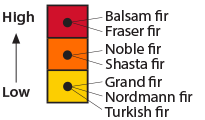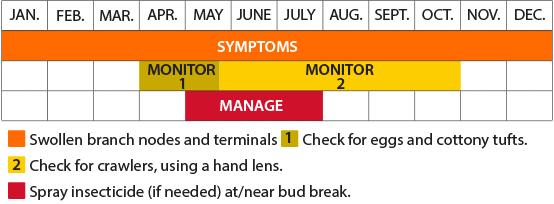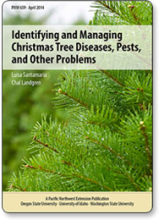Adelges Piceae (exotic pest from Europe)
- Yellow needles and premature needle loss
- Flat top or crooked terminal
- Gouting (swelling) around buds and internodes
- Stiff, inflexible trunk and swollen lateral branches
- White, cottony masses on trunk and large branches
- Dead shoots or branches
- Localized areas in the field
- Root problems
- Severe aphid damage
- Scout at waist height for swollen areas (white, cottony masses) in branches and main trunk.
- Check flexibility of the upper stem.
- Look for poor growth of trees or affected trees that have lost flexibility in the upper stem.
- Examine stumps for reddish discoloration.
- Spray insecticides at high volume and pressure during the first generation crawler stage.
- If the adelgid is found, treat the field prior to bud break of the following season.
- Clear-cut infested blocks. Do not leave infested trees in the field, and avoid cutting during crawler activity.

- High susceptibility: Fraser fir, Balsam fir
- Medium susceptibility: Noble fir, Shasta fir
- Low susceptibility: Grand fir, Nordmann fir, Turkish fir

- Look for swollen branch nodes and terminals: All year round
- Check for eggs and cottony tufts: April through Mid-May
- Check for crawlers, using a hand lens: Mid-MAy through October
- Spray insecticide (if needed) at/near bud break: May through July


